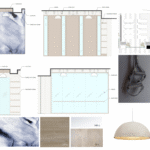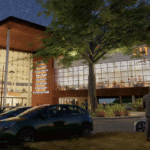
4 Distinctive Signage Ideas for Trendy Mixed-Use Developments
As cities become more compact and space becomes more limited, developers are having to get creative. It’s rare to find a plot of land that is created just for housing or retail within an urban area. Today’s construction projects are mixed-use developments that include trendy apartments, shops, restaurants, and parking garages all built within one single space.
This model of mixed-use building is efficient and creates more space for people to live and work. But, for the properties to be appealing to residents and businesses alike, there needs to be some signage considerations that make it a cool place to live, work, and play.
Here are some ideas for signage for mixed-use developments that can make these properties interesting and desirable for residents, visitors, and businesses.
1. Using Signage to Designate a Property as a District
One of the primary trends in mixed-use development is the transition from treating projects like buildings to districts. Instead of creating a single complex, developers can make communities that residents both live in and enjoy outside of their unit. This is a particularly optimal choice if they are building in an area without many residential amenities nearby.
For example, The District Flats in West Palm Beach’s Warehouse District has coffee shops, gym space, hair salons, bars, and breweries. It is built to cater to the needs of everyone living there. Instead of traveling to work out or get coffee, residents can simply head downstairs. This retail space also attracts other residents in the area to the new district.
Signage is essential for showcasing a mixed-use development as a district. The right signs communicate with both residents and locals. If non-residents think that the retail space is part of the apartment complex, they will ignore it and those businesses will suffer. With clear signage, people who pass by can notice various retail shops and businesses within the apartment building.
2. Using Signage to Express the Brand of the Building
A way to further designate a mixed-use development as a district is by giving it a sense of branding. Signage can play a big role in defining the brand of mixed-use facilities. It can be used to connect businesses within the space, as well as define the building as a whole.
The brand can be represented through unique building nameplates that utilize oversized illuminated designs or other custom architectural elements. For example, we often see “oasis” type branding or “resort-style” design in Florida. The palm trees and tropical climate are ideal to develop an apartment complex or retail space that promotes a sense of calm and relaxation.
To create a brand for the building, there also needs to be a common thread that connects every business within a mixed-use space. An on-property gym and a coffee shop might not have much in common, but the signage for both their businesses within a single space needs to reflect a certain brand vision or lifestyle. Each business needs its own unique branding to attract customers, but there also needs to be a unifying design to create a positive visual experience. Some mixed-use spaces accommodate this by limiting businesses certain signage colors (like black and white) while others limit the size of the signage that each vendor is allowed to have.
3. Using Creative Signage For Wayfinding
It’s not uncommon to see large mixed-use properties that attract retailers of different sizes and brands. For example, a block of mixed-use space might have restaurants and bars on the ground floor – attracting foot traffic – but then have offices for CPAs, law professionals, and co-working spaces in the second and third stories. Depending on the architecture of the city, there may be additional levels with condos and apartments above that.
These elevated businesses need to attract customers and entice potential residents but most ground-level businesses don’t want to lose their own signage space. There are multiple signage solutions to consider for improved navigation and brand promotion.
Some property owners create digital wayfinding maps, similar to those at shopping malls, guiding customers to different businesses. Others set up wayfinding signs in courtyards as a way to attract and assist visitors. While shoppers might enter a courtyard to eat or to rest after shopping, they can learn about the other businesses from the wayfinding signs provided.
4. Using Design to Highlight Parking & Transit Options
If a mixed-use space is going to attract residents, employees, customers, and visitors, it needs to accommodate a large group of people. This means needing a large parking garage and a variety of transportation options that are easy to access.
Transit options are often the first impression that people have of a mixed-use space. If it is hard to find parking or if there are no bike racks nearby, customers will grow frustrated with the area before they even fully arrive.
The signage for mixed-use developments needs to guide customers to reach their destination safely, while also showcasing the building’s brand in a fun and inspired way. Mixed-use developments can use eye-catching wayfinding signs and architectural elements (like this high-end package we designed for a Tampa multi-family building) to make it easy for visitors to find transit options, while also adding to the style of the building.
Develop Signage for Mixed-Use Developments
The signage placed in a mixed-use development needs to reflect its various vendors and amenities while still providing a unique brand. On top of this, it also needs to provide value for customers who are trying to navigate the various businesses and stores nearby. This is why development teams need to bring in signage and wayfinding experts to guide their target audiences.
If you’re working to build a multi-use space, contact the experts who know how to promote different business types and develop signage for mixed-use developments. Contact Creative Sign Designs today and ask for a consultation or meeting about your project.




